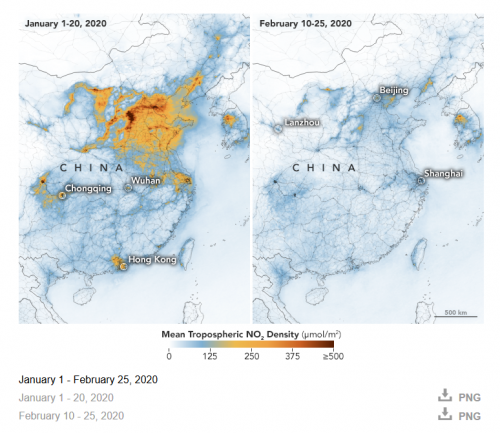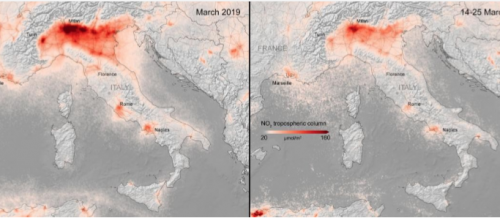The situation
A pneumonia of unknown cause detected in Wuhan, China was first reported to the World Health Organisation (WHO) Country Office in China on 31 December 2019.
The outbreak was declared a Public Health Emergency of International Concern on 30 January 2020. On 11 February 2020, the WHO announced the new coronavirus as COVID-19.
The result has been human distress and loss of life as well as demobilisation of the global economy, caused largely by the restriction on movement of people, goods and services and closure of industrial facilities.
Although at this time, figures are based on an early assessment of the impacts of COVID-19, a result of these negative impacts is a reduction in greenhouse gas emissions and improvement in air quality across many parts of the globe.
Emission impact
China emissions impact
China is the world’s largest CO2 emitter – accounting for more than 25% of the 36 billion tonnes of annual global CO2 emissions.
Primarily driven by reduced demand for coal consumption and oil-refinery utilisation, China saw a total emissions reduction of around 18% between early February and mid-March (emissions reductions for the first 4 weeks after Chinese New Year were over 25%). Demand returned to normal levels over an extended seven-week period, bringing the reduction so far equating to around 250MtCO2.
That is equivalent to:
- Over half the UKs annual carbon emissions or
- The annual carbon emissions of Florida but
- 25% reduced energy consumption and emissions for two weeks would only reduce annual figures by ~1%.
Source – CarbonBrief (2020, February 19) – Analysis: Coronavirus has temporarily reduced China’s CO2 emissions by a quarter.
EU emissions impact
An initial impact assessment carried out using early demand decreases shown in Italy, assumed industry production cuts and continued travel restrictions following COVID-19 control measures by Governments showed some significant results.
A substantial drop in EU Emissions Trading System (ETS) emissions by around 389million tonnes during 2020 compared to pre-COVID environment (-24.4%) may be seen as:;
- Power Sector Emissions; -12.7% = 87.6m tonnes.
- Industry Sector Emissions; -30% = 265.0m tonnes (2020).
- Aviation Sector Emissions; 35.7m tonnes.
That is equivalent to:
- 9% of the EU’s cumulative 2020 emissions target
or - The annual carbon emissions of France.
Source – European power and carbon markets affected by COVID-19 – an early impact assessment
Air Pollution
China’s air pollution
A significant drop in nitrogen dioxide (NO2) has been seen. This is a noxious gas (NOx) emitted through burning of fossil fuels for production of motor vehicles, operation of power plants, and industrial facilities. In the week after the 2020 Chinese New Year holiday, average levels were 36% lower over China than in the same period in 2019.

Source – CarbonBrief (2020, February 19) – Analysis: Coronavirus has temporarily reduced China’s CO2 emissions by a quarter.
EU air pollution
In the UK using measured and business as usual assessment concentrations, estimated changes due to the COVID-19 pandemic show that NOx concentrations are predicted to have typically reduced by around 30 – 40%.
Source: Ricardo (2020, March 31) An analysis of Covid-19 lockdown on UK local air pollution
In the Paris region, as a result of reduced traffic by between 70 – 90%, air quality monitor Airparif logged 20 – 30% cleaner air during the first days of confinement compared to usual levels of the same period. The result is attributable to the 60% drop in the level of NO2 in the air during this period.
Airparif also state the reduction in pollution also came with a 30% decrease in carbon emissions.
Source: rfi (2020, March 25) Covid-19 lockdown brings cleaner air to Paris region
Images captured by one of the European Space Agency’s (ESA) Copernicus satellites showed significant reductions in NO2 concentrations over Paris, Madrid and Rome from 14 – 25 March, compared to the same week in 2019 following a drop in economic activity resulting from confinement;

What does this mean?
From the current data and analysis, the reduction in people movement has seen a drop in pollution and emissions across the Globe, where the source of COVID-19, China, seeing a reduction in emissions by 25% in just a 4-week period, through to countries just grappling with the pandemic, such as America, seeing New York’s air pollution drop by nearly 50% compared to this time last year.
It’s clear that the low movement of people, and reduction in manufacturing, has seen affect on emissions, and lessons will be learned on how to tackle the UK’s, and other countries, approach to our Net-Zero future







